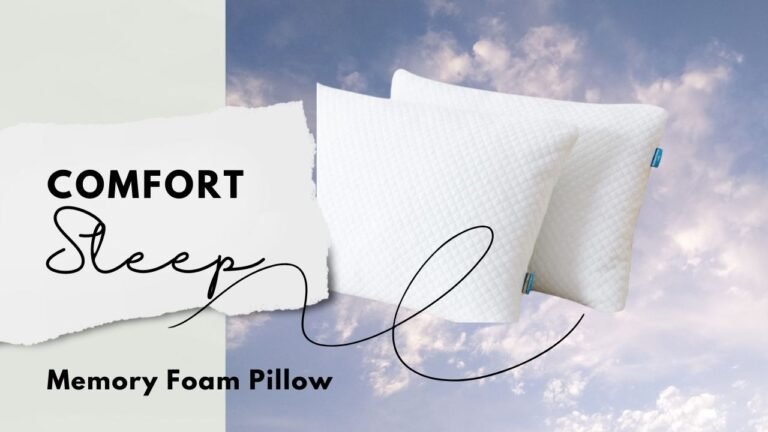4 Essential Aspects of Memory Foam Pillows: Uses, Benefits, Drawbacks, Seasonal Fit
In the quest for a good night’s sleep, the choice of pillow plays a crucial role. Among the myriad options available, memory foam pillows have emerged as a popular choice, prized for their unique properties and ability to provide customized support. In this comprehensive guide, we delve into the uses, benefits, and drawbacks of memory foam pillows, while also exploring their suitability for every season. Whether you’re considering investing in a memory foam pillow or simply curious about their efficacy, this article aims to provide you with all the essential information you need to make an informed decision.
Understanding Memory Foam Pillows:
Memory foam, also known as viscoelastic foam, was originally developed by NASA in the 1960s for use in spacecraft cushions to provide optimal support and cushioning during space travel. Over the years, memory foam has found its way into various consumer products, including mattresses, mattress toppers, and pillows. Memory foam pillows are crafted from viscoelastic foam, a material that responds to heat and pressure, conforming to the shape of the body for personalized support.
Uses of Memory Foam Pillows:
Memory foam pillows are primarily designed to offer support and comfort during sleep, catering to individuals with various needs and preferences. Here are some common uses of memory foam pillows:
- Neck and Shoulder Support: Memory foam pillows are renowned for their ability to conform to the contours of the head and neck, providing targeted support and alleviating pressure points. This makes them particularly beneficial for individuals suffering from neck pain, stiffness, or discomfort.
- Spinal Alignment: Proper spinal alignment is essential for a restful night’s sleep and overall spinal health. Memory foam pillows help maintain neutral alignment by supporting the natural curvature of the spine, reducing strain on the neck, shoulders, and back.
- Pressure Relief: Memory foam pillows distribute weight evenly across the surface, reducing pressure on sensitive areas such as the neck, shoulders, and head. This can help alleviate discomfort and improve sleep quality, especially for individuals prone to tossing and turning.
- Allergy Relief: High-quality memory foam pillows are naturally hypoallergenic and resistant to dust mites, mold, and other allergens. This makes them an excellent choice for allergy sufferers seeking a clean and healthy sleep environment.

Benefits of Memory Foam Pillows:
Memory foam pillow offer a plethora of benefits that contribute to better sleep quality and overall well-being. Here are some key advantages of memory foam pillow:
- Customized Support: One of the standout features of memory foam pillow is their ability to mold to the unique shape of the sleeper’s head and neck, providing personalized support and comfort.
- Pressure Point Relief: Memory foam pillow excel at relieving pressure points by evenly distributing weight and reducing stress on sensitive areas. This can help alleviate discomfort and promote deeper, more restorative sleep.
- 3. Durability: High-quality memory foam pillow are known for their longevity and resilience. Unlike traditional pillow that may lose their shape and support over time, memory foam pillow maintain their integrity for years, providing consistent comfort and support.
- Motion Isolation: Memory foam pillow absorb movement and minimize disturbances, making them an ideal choice for couples or individuals who are easily disturbed by movement during sleep.
Drawbacks of Memory Foam Pillows:
While memory foam pillow offer numerous benefits, they are not without their drawbacks. Before deciding to make a purchase, it’s crucial to take into account these potential limitations:
- Heat Retention: One common complaint associated with memory foam pillow is their tendency to retain heat. The dense nature of memory foam traps body heat, leading to discomfort, especially for individuals who sleep hot or live in warmer climates.
- Initial Odor: Memory foam pillow may emit a chemical odor known as off-gassing when first unpackaged. While this odor typically dissipates over time, it can be bothersome to some users, particularly those with sensitivities to strong smells.
- Firmness: Memory foam pillow tend to be firmer than traditional pillows, which may not be suitable for everyone’s preferences. Some individuals may find memory foam pillows too firm, especially if they prefer a softer sleeping surface.
Seasonal Suitability of Memory Foam Pillow:
One common question among prospective memory foam pillow buyers is whether these pillows are suitable for use in every season, particularly in regions with diverse climates like India. Let’s explore the seasonal considerations of memory foam pillows:
Summer:
During the hot and humid summer months, heat retention can be a concern with memory foam pillow. The dense structure of memory foam traps body heat, potentially leading to discomfort and disrupted sleep. However, many manufacturers now offer memory foam pillow with cooling technologies, such as gel-infused foam or ventilated designs, to enhance breathability and regulate temperature. Additionally, using breathable pillowcases or pillow covers made from moisture-wicking materials can help mitigate heat retention and improve comfort during the summer.
Winter:
In contrast to summer, memory foam pillow can provide warmth and coziness during the colder winter months. The conforming properties of memory foam create a snug and supportive sleeping surface, promoting comfort and relaxation on chilly nights. However, it’s essential to strike a balance between warmth and breathability, as excessive heat retention can still be a concern, particularly for individuals who tend to sleep hot.
Transition Seasons:
During the transitional seasons of spring and autumn, memory foam pillows can offer versatility and comfort across a range of temperatures. With proper ventilation and temperature regulation features, memory foam pillows can adapt to changing weather conditions, providing consistent support and comfort year-round. It’s essential to adjust bedding layers and airflow settings to maintain a comfortable sleep environment during these transitional periods.
Conclusion:
Memory foam pillows are highly valued for their capacity to offer tailored support, alleviate pressure, and endure over time, rendering them a favored option in the realm of pillow selection for sleepers globally. While they offer numerous benefits, such as personalized support and pressure relief, memory foam pillow also come with potential drawbacks, including heat retention and initial odor. When considering the seasonal suitability of memory foam pillows, it’s essential to take into account factors such as heat retention and breathability, particularly in regions with diverse climates like India. With proper care and consideration, memory foam pillow can offer year-round comfort and support, contributing to better sleep quality and overall well-being. Whether you’re seeking relief from neck pain or simply aiming to improve your sleep experience, a memory foam pillow may be the solution you’ve been searching for.


